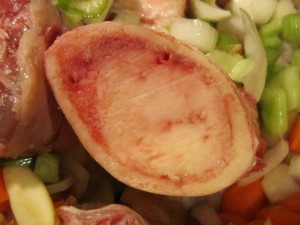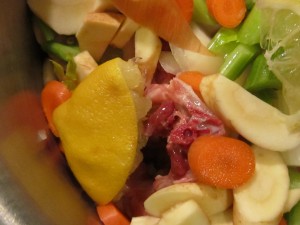Note from Leni Reed Nazare(3 years after writing the post below): Since writing the post below, I have worked out a new way to make chicken broth/stock, as described in the post How to Make a Great Chicken Broth Stock.
============================================================================I woke up this morning to the wonderful aroma of stock simmering on the stove. It’s been simmering for 14 hours and I intend to let it do so for another 5 or 6 hours. After a total of 19 or 20 hours, great flavor and lots of bone-building minerals and collagen will have leached out of the bones and into the stock.
I’m really obsessed with making stock making these days! It’s so healthy! And it brings me back to the days when my mom made stock in the “deep well” in our gas stove and my grandmother made a clear chicken soup (stock) flavored with dill for every family gathering.
I am excited to share with you my basic bone stock recipe and and a few tips that I have picked up from reading and experimenting these past few weeks.
RECIPE FOR STOCK
- 1 part bones
- 1 part vegetable “formula” (shown below)
- A few additions (shown below)
- Cold filtered tap water to cover contents of pot with 2 inches of water
Note: I use a mixture of bones. In the stock pictured below, I had beef marrow bones, oxtails, chicken backs, and chicken necks. In the future, I would like to add knuckle bones and also chicken feet because they are excellent sources of collagen (which my doctor who is an expert in osteoporosis says is good for bones, though I have not found much literature on this yet). And, if available, I get bones from grass-fed beef and the most humanely raised chickens that have not been given antibiotics or hormones.
For 16 cups of finished stock, I used: 1.5 pounds chicken backs and necks, 1.5 pounds beef marrow bones, and 1 pound oxtails.

VEGETABLE FORMULA
2 parts yellow organic onions
Note: I remove and discard the first layer of the brownish onion peel. Then I remove the inner layer(s) of the brownish onion peel and toss those into my stock pot. Next, cut off the two ends of the peeled onion, and then roughly chop the onion.
1 part carrot, sliced
1 part celery (including the flavorful leaves), sliced
For 16 cups of finished stock, I used: 1 large onion, 3 medium carrots, 2 stalks celery.

ADDITIONS
The amounts of these additional ingredients should be proportional to the quantity of stock you are making.
- Bay leaves
- Whole black peppercorns
- Apple cider vinegar or lemon juice.
- Lemon juice and vinegar add acid which helps leech the calcium and other minerals out of the bones – and does not give a lemony or vinegary flavor – unless you use too much.
- Note new directions as changed in 2014: Do not toss lemon halves into the pot (as you see in the photo) as it makes the stock bitter.
- An aside – what to do with the lemon peel? Lemon peel is nutritious and flavorful so just cut it up and refrigerate to use in beverages like hot tea or hot lemon peel and juice flavored water.
For 16 cups of finished stock, I used: 1 fresh organic lemon (and next time I’ll try 2 lemons), 2 large bay leaves, and 6 whole peppercorns.

DIRECTIONS for making stock — could not be easier — all you need is a big pot and patience
- Bring the contents of the pot to a boil.
- Turn the heat down to a simmer and let the pot simmer, covered, for about 20 hours. Note: If you do not want to leave the pot simmering on the stove, you can always put it in the oven. For a discussion on the correct oven temperature for simmering stock, see Chowhound. Or if you prefer, use a slow cooker as they do for this chicken stock recipe.
- When the stock has been simmering for hours and the marrow bones will give up their marrow easily, insert a chopstick or blunt knife into the marrow and let the marrow slide out and into the stock.
- When the cooking time is up, remove the bones, most of which will not have much meat on them anymore. I used a pair of thin tongs to remove the dainty chicken bones, but next time I might just tie the chicken (or at least the chicken necks) up in cheesecloth so I would not have to fish out all those little neck bones.
- Pick the remaining meat off the bones and add it back to the pot, or if you wish, reserve the meat for another use.
- Remove the bay leaves, lemon halves, and onion peel, and discard after you have squeezed the stock out of the lemon halves. (See tip below.)
- In the interest of food safety, cool the stock down as quickly as possible (See “Cool Your Stock” shown below.)
- Refrigerate the stock in glass containers, for no more than 2 or 3 days. For longer storage, freeze.
- Freeze what you can’t use in 2 or 3 days. Before freezing, remove the fat layer from the top of the soup. It’s easier to remove it now than it will be when it’s frozen or partially defrosted.
The stock making directions in this post do NOT make a clear stock. If you want a clear stock, you need to modify the directions so that you:
SKIM THE FOAM(scum) that forms at the top of the simmering soup and discard the foam. (I read that contrary to wham a lot of chefs say, the foam doesn’t have an affect on the flavor…and since I can’t find any effect, I don’t skim it off.)
Simmer stock UNCOVERED and add water as needed.
STRAIN OUT all the vegetables and REMOVE the meat.
DIRECTIONS FOR COOLING AND STORING STOCK – be sure to read!
Since stock is a nutrient rich medium (a great place for bacteria to flourish), so it’s important to cool your stock quickly.
COOL YOUR STOCK
For food safety reasons, cool your stock quickly! To do this, I put empty glass storage bowls into a big pan. Then I add ice cubes to the pan scattering them around the bowls. Next I ladle the hot soup into the bowls. Then, I pour cold water over the ice to make an ice-water bath that the bowls with the soup sit in. After about 1 minute, I stir the stock. After another minute or two, I stir it again, and let it sit until it’s cool enough to refrigerate or freeze.
And when I make a lot of stock at one time – and I mean a lot (about 10 quarts), putting even warm stock into the refrigerator and freezer, is not that great for the refrigerator or freezer ,and it will temporarily raise the temperature of the refrigerator so it’s a bit higher than the safe temperature (40 degrees F and under). That’s not a great idea. So what to do?
So here’s are two nifty tricks for cooling your stock:
1. A day or so before you plan to make beef stock, make some beef stock ice cubes out of a new box of store-bought beef broth. (Or, if you’re thinking farther ahead, when you make a fresh batch of beef stock, use some of the freshly made stock to make the ice cubes you will use to cool the next batch of beef stock you make. For food safety: Always make your ice cubes out of a fresh batch of your homemade stock.) Then toward the end of the cooling process described able, just throw a few ice cubes of beef broth into the stock to get it cooled down some more!
2. In the summer, when cherry tomatoes are at their best, freeze some of them in plastic baggies. Then throw a few frozen cherry tomatoes into each bowl of your freshly made stock after it’s been cooled by the method I’ve just described.

STORE STOCK IN REFRIGERATOR OR FREEZER
Cover the cooled stock and and refrigerate the stock, for no more than 2 or 3 days.
For longer storage, freeze.
I like to have small portions of stock available for later – to use in cooking or as a base for making a single serving of soup. So I always freeze some of the stock in silicone muffin pans. Details of how I do this are given in the post, Silicone Muffin Pans – A Kitchen Staple – But Not For Baking!
NOTES
- Remove the layer of fat on top of your stock right before you are ready to consume the stock as is or use it in cooking.
- Some people make stock in a slow cooker (crock pot) and others make it in a pressure cooker.
MORE INFORMATION
- Chowhound discussion board: information about making chicken stock , making chicken broth from bones ,and beef bones used for stock.
- International variations on chicken stock recipes: whats4eats.
- Tips on making chicken stock, see About.com.
- Chicken feet – for making stock that’s full of gelatin and extra delicious. Here’s how to prep chicken feet for your stock pot.
- Beef – recipe based on Michael Ruhlman’s stock recipe as given in his book, Ratio.
- Nutrition of bone broth:
- Minerals: Calcium, magnesium, and other minerals leach out of the bones and into the soup.
- Gelatin: From the dissolved collagen, gelatin may strengthen nails and hair, support connective tissue, and help strengthen bones.
- Other nutrients for which there are many claims: While I can’t find research to support these claims, that doesn’t mean they are not true. As is often the case, anecdotal evidence has a basis in fact. For more information about other possible benefits see: SCD Lifestyle article and Mark’s Daily Apple article.
WHAT CAN I DO WITH STOCK?
Just about everything! In upcoming posts, I’ll tell you what I’m doing with mine…
